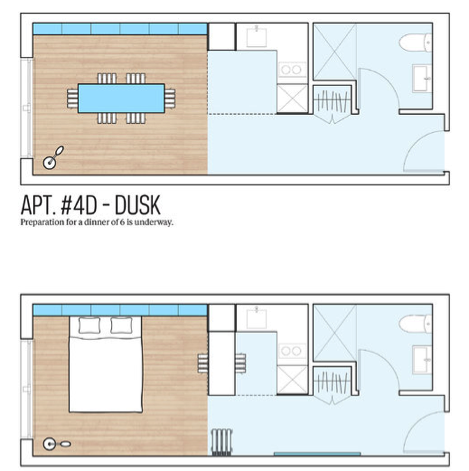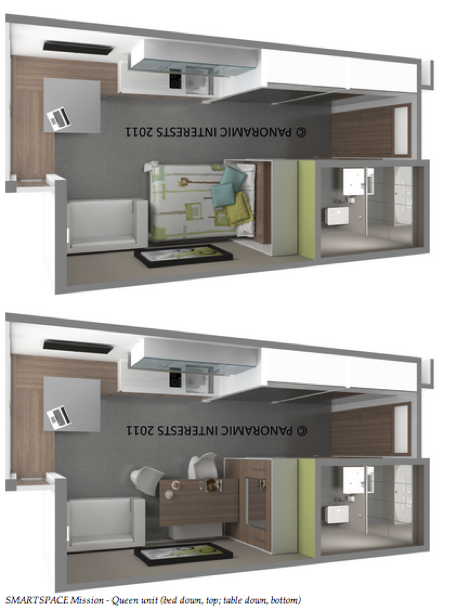This article is from our friends at LearnVest, a leading site for personal finance.
What would you give up in order to pay less in rent?
For New Yorkers, Mayor Bloomberg is hoping the answer is less space—a lot less space. In late January, Bloomberg announced the winner of a contest to build 55 micro-units, or apartments between 250 and 370 square feet, on a city-owned lot on Manhattan’s east side.
Rent prices for the tiny, prefab apartments—aimed at young, single urban dwellers—will start at $914 and go up to $1,873. Bloomberg hopes that the micro-units will be the first of many tiny, affordable apartments that will help solve the city’s lack of affordable housing. Currently, New York City has a shortage of 800,000 apartments.
New York isn’t the only city looking at tiny apartments as a possible solution to its rental market issues. In the fall of 2012, San Francisco approved an amendment allowing apartments as little as 150 square feet; previously, apartments had to be a minimum of 220 square feet.
Is the rental market so bad that city-dwellers really need to consider such tiny spaces? We’ll examine how the lack of affordable housing hurts the economy, and how micro living spaces could provide a solution.
Lack of Affordable Housing
Currently, nearly 9 million low-income households are on the brink of becoming homeless, according to an analysis by the Center on Budget and Policy Priorities, using data from the Department of Housing and Urban Development. These households are struggling with a lack of housing assistance, the high cost of rent and utilities, or severely substandard living conditions. The number of these at-risk households has grown by 43% since 2007.
It’s not just those with very low incomes feeling the squeeze: Nearly 40% of Americans pay more than a third of their income for housing, according to the U.S. Census. Yet, most personal finance experts recommend people keep housing costs to less than 30% of their income so they have enough breathing room to achieve other financial goals, like saving for major purchases, paying for education costs, or squirreling away for retirement.
How the Housing Problem Hurts Society
The housing crisis affects not only individuals but also the economy. If you can’t effectively save for retirement because you spend so much on housing, you’ll be more likely to depend on government benefits, which is a drain on society’s resources.
Lack of affordable housing can also lead to increased poverty. For the nearly 9 million households at risk of becoming homeless, high housing costs mean skimping on food and medical care, moving frequently to find lower rents—which can interrupt a child’s education—and even experiencing periods of homelessness.
Perhaps most importantly, the lack of affordable housing is an issue that spans suburbs and cities. The subprime mortgage and foreclosure crisis highlighted the dangers of too-high housing costs in suburban areas, and recent attempts to find housing for those displaced by Hurricane Sandy have underscored the lack of quality affordable rentals, with some victims in New Jersey paying as much as $1,800 a month to rent two-bedroom motor homes.
In cities, meanwhile, rents have been skyrocketing. San Francisco saw rents rise 14% in May 2012 compared to the year before, and the same time period brought increases of 11% in both San Jose and Minneapolis, according to Zillow. In urban areas, rising rents mean that middle-class workers like firefighters, police officers, nurses, and teachers have to move far from where they work, creating time-consuming and expensive commutes.
What Do Tiny Apartments Look Like?
In New York City, the micro-units approved by Mayor Bloomberg for construction feature 9-foot-high ceilings, large windows, and Juliet balconies. To maximize the small, under-400-square-foot space, the designers have incorporated features that facilitate storage and can be easily tucked away, like sleeping lofts, Murphy beds, fold-down tables, and stacking chairs.

A Rendering of the Micro-Unit From the New York City Mayor’s Office
Of the building’s 55 units, 40% will be earmarked as “affordable” and put aside for renters earning no more than $77,190 a year. (While this may seem like a comfortable salary, the high cost of living in Manhattan affords a typical “middle-class lifestyle” to those earning $80,000-$235,000 annually.) For those earning less than $38,344, rents will start at $914 a month. In comparison, the average rent for a studio in Manhattan is $2,000 a month.
In San Francisco, a 23-unit building featuring 300-square-foot spaces was built in the fall of 2012. As with the New York City micro-units, San Francisco SMARTSPACE SoMa apartments come equipped with features designed for multi-tasking, like counter space that can be used as a desk or a table that can also function as extra seating.
The majority of the SoMa apartments will rent for $1,500, with five units set aside at below market-rate, for $959 a month. In comparison, the average San Francisco studio now rents for $2,100 a month.

Aside from micro-apartments, tiny homes are also becoming increasingly popular for those who wish to trade unsustainable, sprawling houses for eco-friendly, compact homes—with some as little as 128 square feet!
Tiny apartments and homes could have many positive effects on the economy.
Are There Downsides Associated With Micro-Housing?
Despite the many benefits claimed by the supporters of tiny apartments and houses, there are some negative consequences, too.
However, Mayor Bloomberg points out, “The tenement problem was big families in very small (spaces).” He says, “We’re not talking about that. We’re talking about one or two people who want something they can afford, and they don’t entertain or need big space.”
More From LearnVest

